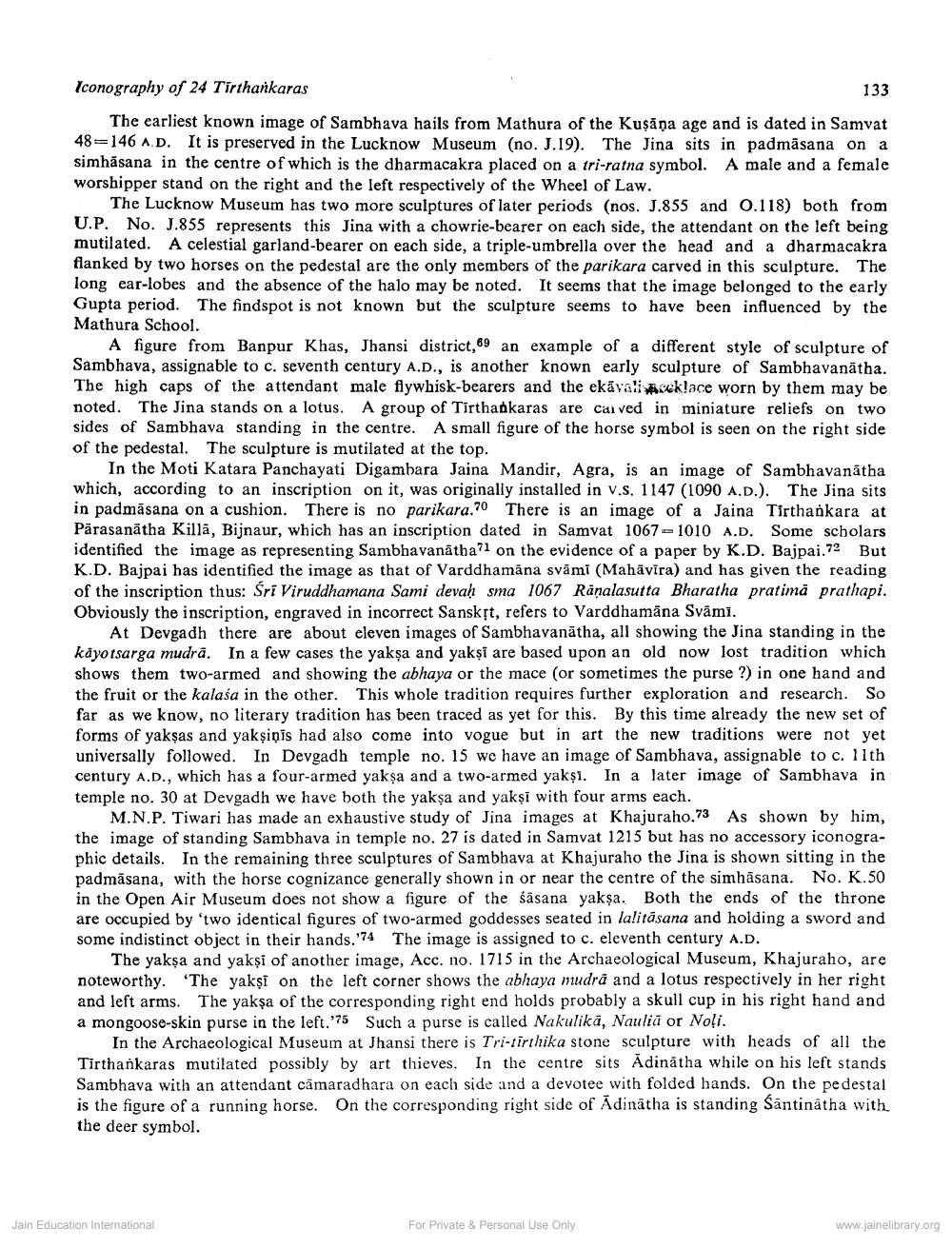________________
Iconography of 24 Tirthankaras
133
The earliest known image of Sambhava hails from Mathura of the Kuşāņa age and is dated in Samvat 48=146 AD. It is preserved in the Lucknow Museum (no. J.19). The Jina sits in padmāsana on a simhasana in the centre of which is the dharmacakra placed on a tri-ratna symbol. A male and a female worshipper stand on the right and the left respectively of the Wheel of Law.
The Lucknow Museum has two more sculptures of later periods (nos. J.855 and 0.118) both from U.P. No. J.855 represents this Jina with a chowrie-bearer on each side, the attendant on the left being mutilated. A celestial garland-bearer on each side, a triple-umbrella over the head and a dharmacakra flanked by two horses on the pedestal are the only members of the parikara carved in this sculpture. The long ear-lobes and the absence of the halo may be noted. It seems that the image belonged to the early Gupta period. The findspot is not known but the sculpture seems to have been influenced by the Mathura School.
A figure from Banpur Khas, Jhansi district,69 an example of a different style of sculpture of Sambhava, assignable to c. seventh century A.D., is another known early sculpture of Sambhavanātha. The high caps of the attendant male flywhisk-bearers and the ekávali Aucklace worn by them may be noted. The Jina stands on a lotus. A group of Tirtha karas are calved in miniature reliefs on two sides of Sambhava standing in the centre. A small figure of the horse symbol is seen on the right side of the pedestal. The sculpture is mutilated at the top.
In the Moti Katara Panchayati Digambara Jaina Mandir, Agra, is an image of Sambhavanātha which, according to an inscription on it, was originally installed in v.s. 1147 (1090 A.D.). The Jina sits in padmāsana on a cushion. There is no parikara.70 There is an image of a Jaina Tirthankara at Pärasanātha Killa, Bijnaur, which has an inscription dated in Samvat 1067 - 1010 A.D. Some scholars identified the image as representing Sambhavanāthal on the evidence of a paper by K.D. Bajpai.72 But K.D. Bajpai has identified the image as that of Varddhamăna svami (Mahāvīra) and has given the reading of the inscription thus: Sri Viruddhamana Sami devah sma 1067 Rāņalasutta Bharatha pratima prathapi. Obviously the inscription, engraved in incorrect Sanskst, refers to Varddhamana Svāmi.
At Devgadh there are about eleven images of Sambhavanatha, all showing the Jina standing in the käyotsarga mudrā. In a few cases the yakșa and yakși are based upon an old now lost tradition which shows them two-armed and showing the abhaya or the mace (or sometimes the purse ?) in one hand and the fruit or the kalasa in the other. This whole tradition requires further exploration and research. So far as we know, no literary tradition has been traced as yet for this. By this time already the new set of forms of yakşas and yaksinis had also come into vogue but in art the new traditions were not yet universally followed. In Devgadh temple no. 15 we have an image of Sambhava, assignable to c. 11th century A.D., which has a four-armed yaksa and a two-armed yaksi. In a later image of Sambhava in temple no. 30 at Devgadh we have both the yaksa and yaksi with four arms each.
M.N.P. Tiwari has made an exhaustive study of Jina images at Khajuraho.73 As shown by him, the image of standing Sambhava in temple no. 27 is dated in Samvat 1215 but has no accessory iconographic details. In the remaining three sculptures of Sambhava at Khajuraho the Jina is shown sitting in the padmasana, with the horse cognizance generally shown in or near the centre of the simhāsana. No. K.50 in the Open Air Museum does not show a figure of the śāsana yakşa. Both the ends of the throne are occupied by two identical figures of two-armed goddesses seated in lalitásana and holding a sword and some indistinct object in their hands.74 The image is assigned to c. eleventh century A.D.
The yaksa and yakși of another image, Acc. no. 1715 in the Archaeological Museum, Khajuraho, are noteworthy. “The yakşi on the left corner shows the abhaya mudra and a lotus respectively in her right and left arms. The yakşa of the corresponding right end holds probably a skull cup in his right hand and a mongoose-skin purse in the left.'75 Such a purse is called Nakulikā, Nauliã or Noļi.
In the Archaeological Museuin at Jhansi there is Tri-tīrthika stone sculpture with heads of all the Tirthankaras mutilated possibly by art thieves. In the centre sits Adinātha while on his left stands Sambhava with an attendant câmaradhara on each side and a devotee with folded hands. On the pedestal is the figure of a running horse. On the corresponding right side of Ādinātha is standing Santinātha with. the deer symbol.
Jain Education International
For Private & Personal Use Only
www.jainelibrary.org




